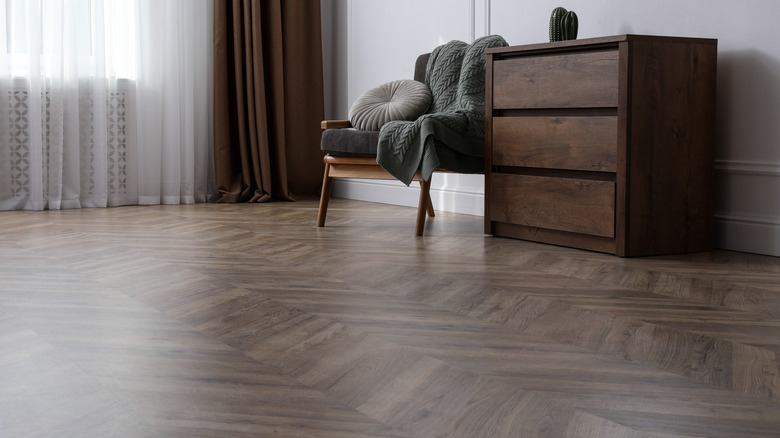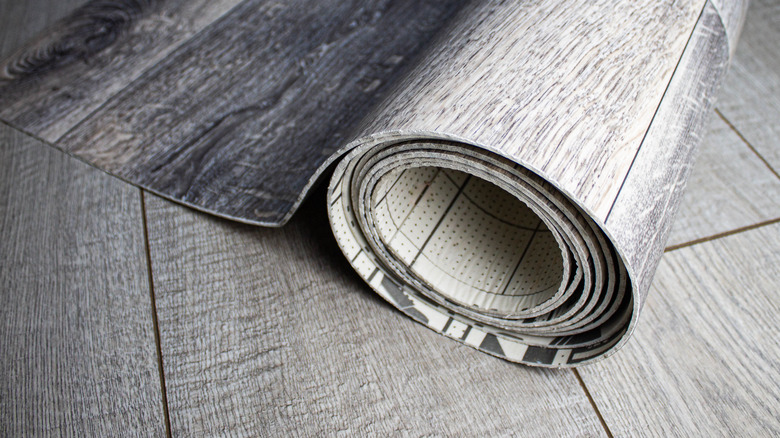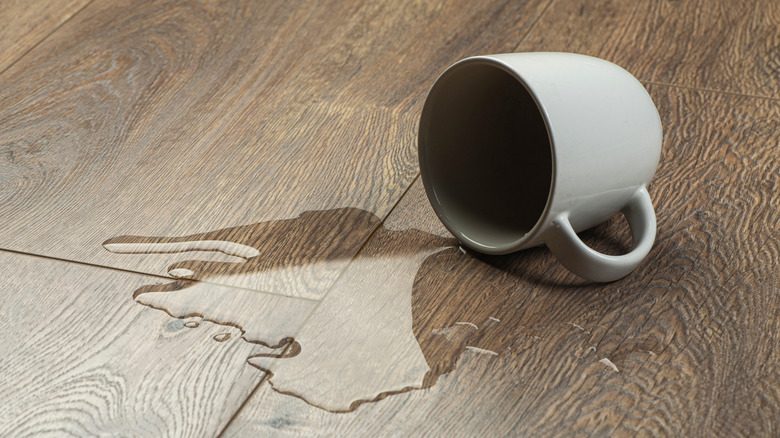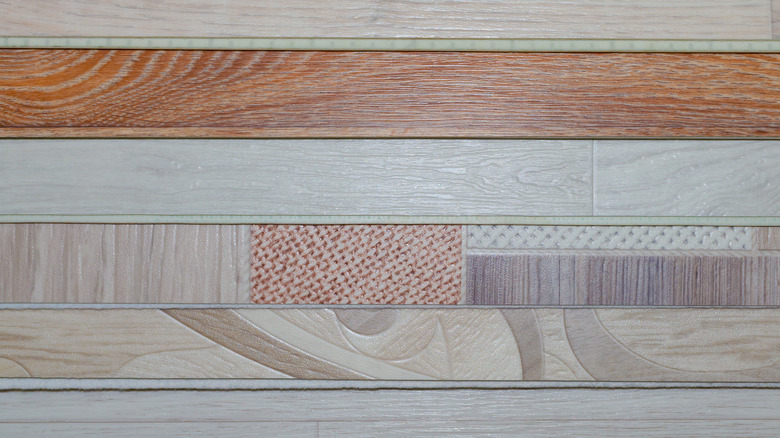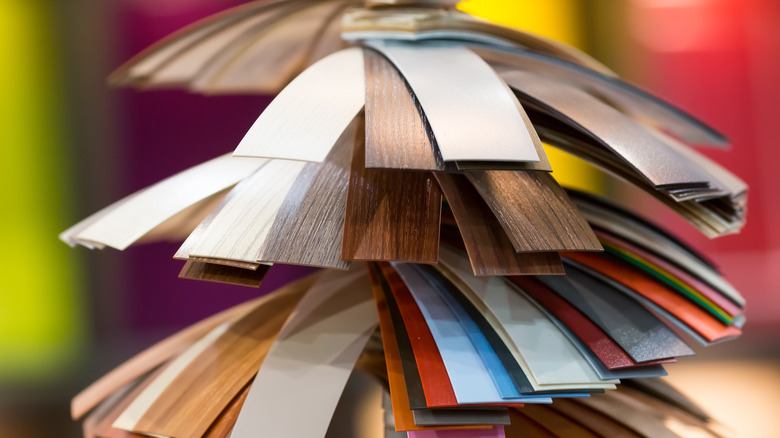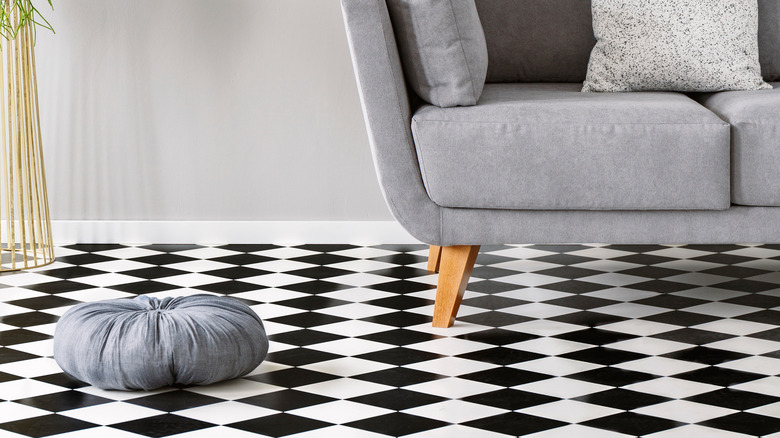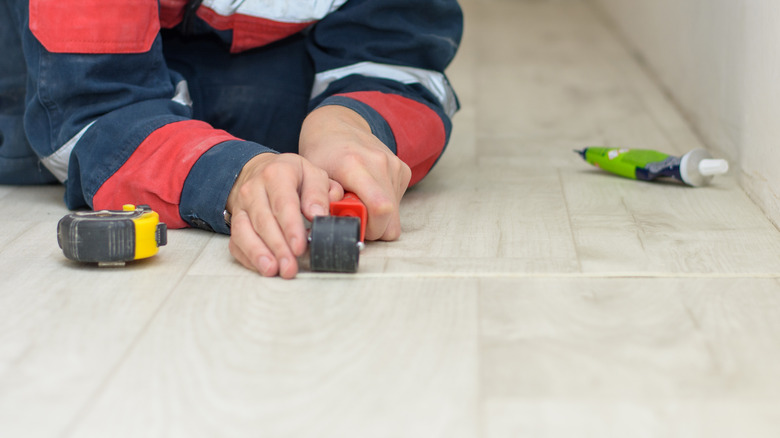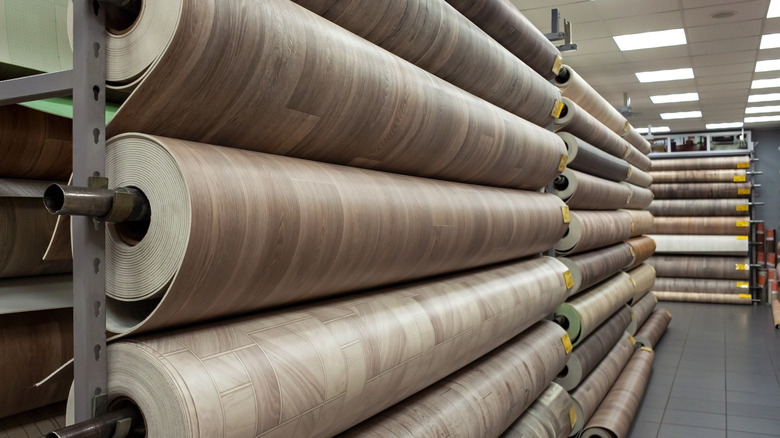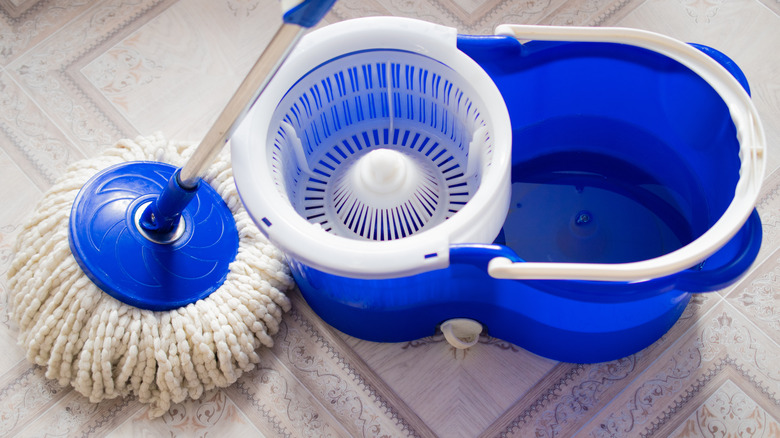What Is Linoleum Flooring And How Is It Different From Wood?
When it comes to linoleum, you don't have to limit your imagination to the television sitcoms of old or to the hallways of your elementary school. In fact, it's making a big comeback to the realm of home interior design. Specifically, for homeowners who are looking for a sustainable flooring option, linoleum flooring proves to be one of the best choices.
Aside from actual hardwood flooring, linoleum comes in as a close second for being the ultimate eco-friendly flooring. The name itself gives you an idea of how "green" a concept linoleum is since the term is a Latin combo, per This Old House, of "linum" or flax and "oleum" which means oil. Along with linseed oil, linoleum is fabricated from wood flour, cork dust, pine resin, ground limestone, and natural mineral pigments that are pressed onto a jute or canvas backing. Often, linoleum flooring is mistaken for vinyl tiles or sheets which are made primarily from PVC. Also, linoleum gets interchanged with laminate flooring which again, is an entirely different material that's pressed onto wood.
How long has linoleum been around?
When you picture a linoleum floor, you might think of a kitchen design from the '70s or '80s, but this type of flooring has been around since the late 1800s according to Bob Vila. It was manufactured in New York at the American Linoleum Manufacturing Company. With its durability and water resistance, demand for this type of flooring quickly increased among homeowners.
Going into the 20th Century, linoleum flooring gained popularity as an ideal option for high-traffic areas in the home. Furthermore, linoleum became a flooring staple for the commercial and industrial sector. Having the trait being water resistant made it a mainstay for naval ships — though a distinct, heavy-gauge variation was utilized as opposed to the commercial type. In spite of its affordable price, linoleum flooring was also installed in cruise ships like the Titanic. Thus, it gained the reputation of being a luxurious flooring material of choice for areas like a ballroom or banquet area.
How does linoleum flooring differ from wood laminate?
As noted in the Flooring Stores blog, linoleum and laminate are made from completely different materials even if both are wood based. Linoleum is compacted and mounted on a flexible backing created from jute or canvas. Laminate, however, is mounted plywood and possesses a hard surface and backing.
On the surface of both, you can find some varieties that have the appearance of wood. On the one hand, laminate has a veneer that bears resemblance to wooden planks that look more natural or sanded and finished. Likewise, you can find linoleum tiles that also have an outer layer that resembles the look of finished wood as illustrated in Floor Techie. However, the two types of flooring differ greatly in pliability and water resistance. Laminate flooring has more vulnerability to water damage; linoleum, if properly sealed, can withstand some moisture. Also, both need to be installed onto a smooth, solid subfloor.
What are the pros and cons of linoleum versus wood laminate?
Both linoleum and wood laminate prove to be effective in high-traffic areas of the home like entryways, laundry rooms, and kitchens according to the Floor Critics. However, linoleum can be refinished by buffing it if it sustains some light damage. Yet, if you drag something heavy across it, there's a chance that it will scratch off a small piece.
With wood laminate, you would have to replace a whole plank (not an easy fix) to repair any scratches or dings, although overall, this type of flooring is low-maintenance; it only requires sweeping and a periodic polish. With a linoleum floor, though, you would need to mop with warm water and soap once in a while.
Also, they're both resistant to water but vulnerable to heavy spills or flooding. Thus, neither flooring is truly waterproof even after sealing. Finally, in regard to installation, the laminate can be a weekend DIY project with larger areas taking longer. The installation of a linoleum floor for an expansive area of your home requires a professional.
What are the different types of linoleum?
You might envision a large 6 x 6 foot sheet of linoleum, but that is just one type, as noted by the Do It Yourself blog. For this type, you would need a master floor installer who has the skills to accurately measure and cut the sheet, especially if it has to go around any built-in structures in the room. This professional would also have the necessary protective mask and gloves to guard against the fumes and effective bonding of the adhesive.
You also have the tile option which you can install yourself just like vinyl flooring or ceramic tile — but without the need for a saw. This type is not the same as the peel-and-stick vinyl; the material is thicker and pliable, and you still need to apply the adhesive on the floor as you install the tile.
Another type that's also ideal for the do-it-yourselfer is the floating linoleum flooring which comes in planks that contain click and lock edges. The planks are installed onto a frame for an easy fit that doesn't require messy adhesive. Additionally, the Forbo, which is actually a brand name, possesses the quality of hiding dirt. Plus, it's more resistant to heat than other types of linoleum flooring.
What are the different colors and patterns of linoleum?
In addition to the different sizes and shapes of linoleum flooring, you can choose from a variety of colors and patterns as featured in Do It Yourself. First you have the solid colored linoleum that resists fading and discoloration. This type can be found in many distinctive hues. However, if you're looking for something more sophisticated, then a marble patterned linoleum tile would work well for any room size. These come in a variety of shades as well.
For a unique look that blends random texture with color, you can opt for the flecked linoleum flooring. And lastly, you also have the patterned linoleum; this type has many different designs to choose from. The patterns add a burst of color to a room that's already painted in solid, neutral hues, but the tiles can be a bit challenging to install. You would have to ensure that the seams match for continuous symmetric flow. Nonetheless, the results compare well to other types of tiles.
How to implement linoleum flooring into your home design?
Basically, you can incorporate any of the types of linoleum flooring into your room's design. For larger spaces, some sheets of linoleum with either a pattern or solid color would work well. To offset the continuous flow of the space, as in the case of a family room, you throw a rug in the center. One tip to remember is to pair a solid colored rug against a patterned floor and vice versa.
The tiles and floating flooring can work in any size, but prove to be especially effective for smaller spaces like a galley-style kitchen, a mudroom, or a hallway. For these types of spaces, a lighter, solid shade would look more appealing.
Another tip, per Home Decor Bliss, is to install linoleum flooring into a playroom or a bedroom. If you really need to avoid allergens like dust mites, linoleum flooring offers an easy-to-clean option. At times, this type of flooring gets overshadowed by carpet when it comes to bedrooms and playrooms, but it offers a safe alternative that has a softer surface than hardwood flooring or ceramic or vinyl tile. Plus, dust won't last long with regular sweeping and mopping.
How to install linoleum flooring?
First off, as advised by DIY Network, you need to remove the old flooring. Afterward, you'll sweep up all debris, use a shop vac to remove any fine particles, and mop thoroughly. Once your sub-floor has dried, then you can prep the area. If you find cracks or divots, you'll need to apply an embossing leveler and smooth it out with a wide trowel. In the case of sheet linoleum or a floating linoleum floor, you'll need to lay down 1/4 inch thick sheet of plywood.
Once the surface is prepped, in the case of the tiles, you'll mark the center point of the room, place the first tile on the crosshairs, and dry fit some tiles around it to establish the desired pattern. After removing the dry fit tiles, spread the adhesive with a notched trowel and lay down the first tile. Remember to apply enough adhesive for just one tile at a time to avoid drying out the excess. You'll repeat this process until you only have the tiles that'll lay against the walls. For those last few spaces, you'll need to measure areas and mark the tiles to match those gaps. Afterward, you'll use a carpenter's square and utility knife to cut the tiles to fit.
One variation to the process for sheet linoleum is to construct a template of the room from roofing felt. You'll then unroll the linoleum sheet and use the template to trace and cut. The process of spreading the adhesive on the sub-floor and laying out the sheet will be a gradual one. The final step with all types of linoleum flooring is to use a heavy roller to remove the air bubbles.
Installation cost of linoleum flooring
According to Forbes, any of the linoleum types cost much less than wood laminate or ceramic tile. One consideration to remember is that sheet and floating linoleum require a sub-floor, so you'll need to include $6 to $25 for a 4 x 8 foot sheet of plywood. Most likely, unless the space is quite small, you'll need multiple sheets. The total installation cost, including materials and labor, ranges from $550 to $950.
For the linoleum planks, a more recent addition to this category, you'll need to add underlayment which costs $25 to $100 depending on type and quantity. The total cost for installation, including materials and labor, ranges from $525 to $850.
Lastly, linoleum tile comes out as the least expensive with a price range of $390 to $650. Also, for all types, regarding maintenance, you'll need to purchase some sealer which costs $40 to $50. Nonetheless, any linoleum flooring still costs less than other flooring options with the exception of some varieties of vinyl.
How to maintain linoleum flooring
As stated in Forbes, all types of linoleum flooring require daily mopping and polishing as necessary depending on the traffic of the area. Furthermore, all types also need to be sealed once a year to maintain water resistance.
As outlined in SF Gate, the sealing process is quite simple. You'll sweep and mop the floor to completely remove any dust, stains, or dirt. Once dry, you'll start at the corner that's farthest from the doorway and pour the sealer in a zig-zag pattern. After that initial application, you'll mop the sealer over the entire surface. For a bigger space, you'll need to repeat this process while starting at the opposite corner that's also farthest from the doorway. Once the entire floor has been covered, you'll need to wait two to four hours for the sealer to cure. A tip that can guarantee that no one walks on the floor too soon after sealing is to wait later in the day to apply the sealer so that the floor can dry and cure overnight.
Is linoleum flooring safe?
Fortunately, linoleum flooring, according to HGTV, proves to be one of the safest options for your home. It doesn't contain volatile organic carbons, and it's created from all natural materials. In particular, the linseed oil gives linoleum flooring its antibacterial qualities; plus the materials don't retain micro-organisms or allergens, especially with regular cleaning. Also, linoleum flooring would work well in playrooms and family rooms as well as kitchens and entryways. The material is soft (though not as soft as carpet) and bouncy underneath, which means you'll have less of a hazard from a fall than you would landing on tile or hardwood.
Moreover, linoleum flooring is making a popular comeback in homes considering the safety and environmental aspects. With other variations of this flooring to choose from, you have more options of patterns and texture, and the newest generation of linoleum is more durable than '80s predecessor. And being that the cost is affordable, even with professional installation, you can easily incorporate this material into the overall design of your home.
